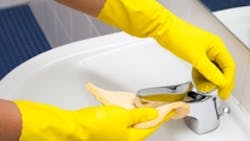Clean and Safe Washroom School Maintenance
Having clean, safe, well-maintained washrooms may not enhance a school’s reputation—the good maintenance practices may not provide any clues about the quality of the teachers or how well students are performing. But when an education facility neglects washrooms and lets them become unsanitary and unsafe havens for vandalism and bullying, that can affect the health and morale of students and staff.
At a minimum, schools and universities need to provide washrooms that are cleaned regularly to kill germs and prevent the spread of disease; that are outfitted with fixtures and equipment that ward off the temptations of vandalism; and that allow for a level of supervision that deters would-be bullies from using a restroom break to harass vulnerable fellow students. In addition, facility managers looking to save energy and cut costs should seek washroom designs that conserve water and rely less on artificial lighting.
Health focus
A poorly maintained school washroom can threaten the health of students and staff—even those who don’t even use the facilities. Without proper cleaning, washrooms can become breeding grounds for germs that can spread disease throughout the school population.
In addition to an effective cleaning strategy, schools can fight the dissemination of germs by selecting the right fixtures and equipment. Frequent and thorough hand washing is a critical step in trying to avoid contact with germs, but even with regular washing, restroom users can pick up germs each time they touch a door handle, a toilet-paper dispenser, a flush handle, a sink faucet, a soap dispenser or a towel dispenser. Equipment that is triggered by motion or is time-controlled enables students to use those fixtures without touching them.
Beware of Bullies
Schools typically don’t have an adult inside washrooms monitoring student behavior. Although that provides washroom users with a level of privacy, it also creates the opportunity for bullies to prey on students trying to use the facilities. Even when a teacher or other adult is stationed outside a washroom, many bullies are devious enough to carry out the harassment without drawing the attention of the adult monitor.
Many students who have experienced bullying in washrooms or who fear that they will be a victim begin avoiding school restrooms rather than put themselves in harm’s way, according to the International Paruresis Association. Someone who suffers from paruresis experiences anxiety if they have to use washroom facilities when others are nearby.
"The unfortunate introduction to the perils of public restrooms has caused problems for many mild-mannered schoolchildren," the association says. "Forcing children of vastly different ages and physical size to use exposed and unsupervised facilities is unwise …. Some targets of this bullying find it difficult to use public restrooms even when they are adults."
Many newer schools have restrooms designed with an open entrance from the hallway so that students inside don’t feel so isolated when using the bathroom. Some designs have placed the sink for washing hands in the hallway instead of inside the washroom so that students spend less time away from the watchful eyes of an adult. Some schools have been known to remove mirrors to stop students from lingering in front of them.
Deterring vandalism
Some of the steps taken to discourage bullying also may be effective in curtailing vandalism in school washrooms. Strategies that enable adults to better monitor student restroom behavior and that minimize the time students spend in the washroom will limit the opportunity for students to vandalize equipment and fixtures.
Choosing the right kinds of equipment in washrooms also can make it too difficult for vandals to inflict damage. Fixtures designed to be tamper- or shatter-resistant and partitions made of materials resistant to graffiti can foil a student seeking to literally leave a mark.
Saving resources
Water is essential to the operation of a washroom, but conservation advocates have found ways for schools and universities to provide washroom facilities with less water going down the drain.
Some older models of toilets use 3.5 gallons per flush. Equipment now available includes ultra-low-flow toilets, which use 1.6 gallons per flush, high-efficiency toilets that use 1.28 gallons per flush, and dual-flush toilets, which use 1.6 gallons to flush solid waste and 1.0 gallons to flush liquid waste.
Many gallons of water also are wasted because of inefficient urinals. The U.S. Environmental Protection Agency says that 65 percent of the urinals in use in the United States—7.9 million fixtures—exceed the federal standard of 1.0 gallon per flush for commercial urinals. Some use as much as five times that amount.
The EPA’s Watersense program, which seeks to encourage conservation and more efficient use of water, calls for urinals that use no more than 0.5 gallons per flush. Some ultra-low-flow urinals use only 0.125 gallons per flush, and several manufacturers offer urinals that use no water.
Sensors and timing device on faucets also help schools conserve water by controlling the flow and not letting a neglectful user leave the faucet open.
In addition to saving water, education institutions can reduce energy consumption in their washrooms with motion detectors and timing devices that shut off lighting when the space is not being used.
- Read the "Regular School Maintenance" sidebar to learn about recommended washroom maintenance.
Kennedy, staff writer, can be reached at [email protected].
Related Stories
About the Author
Mike Kennedy
Senior Editor
Mike Kennedy, senior editor, has written for AS&U on a wide range of educational issues since 1999.
